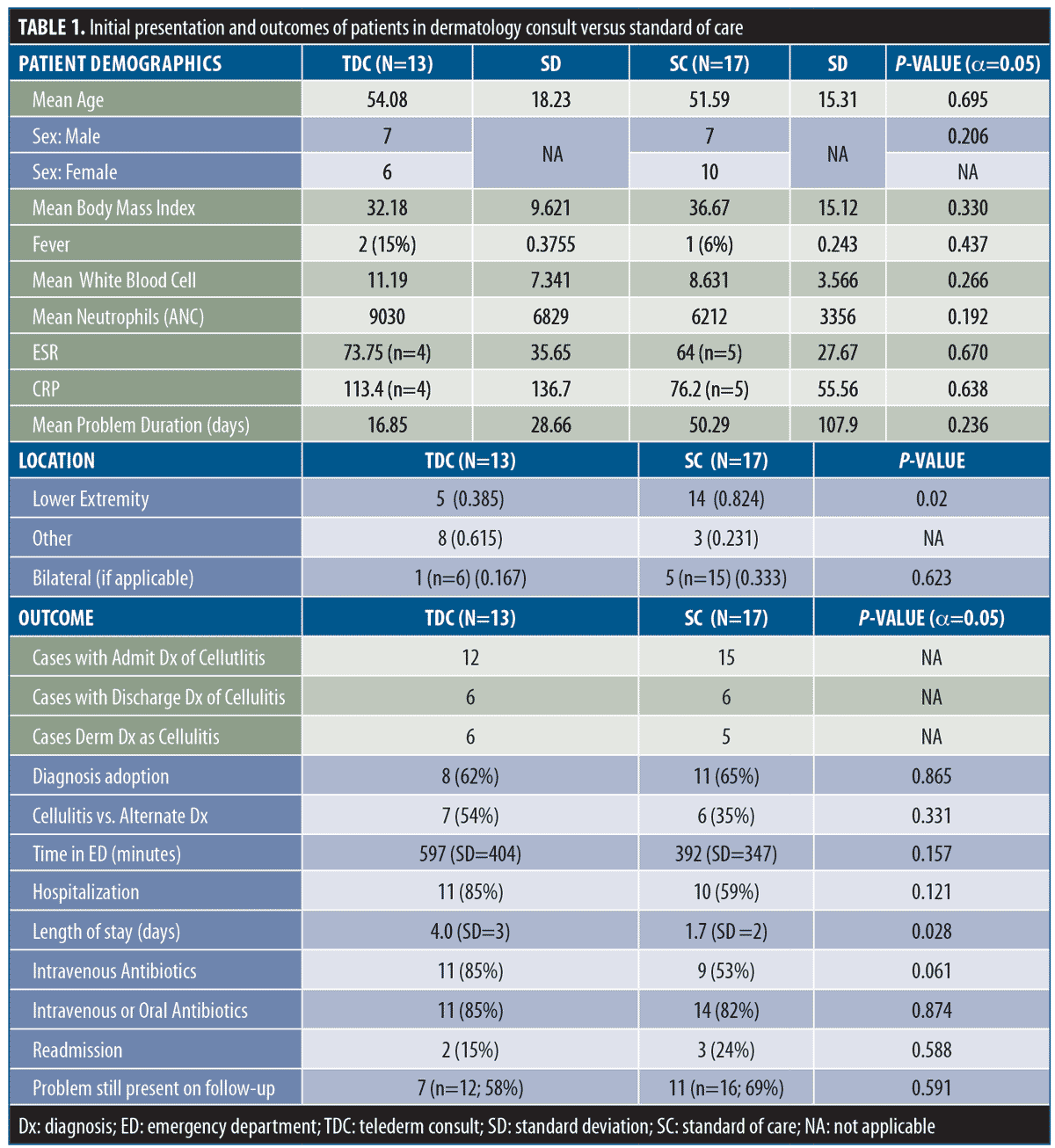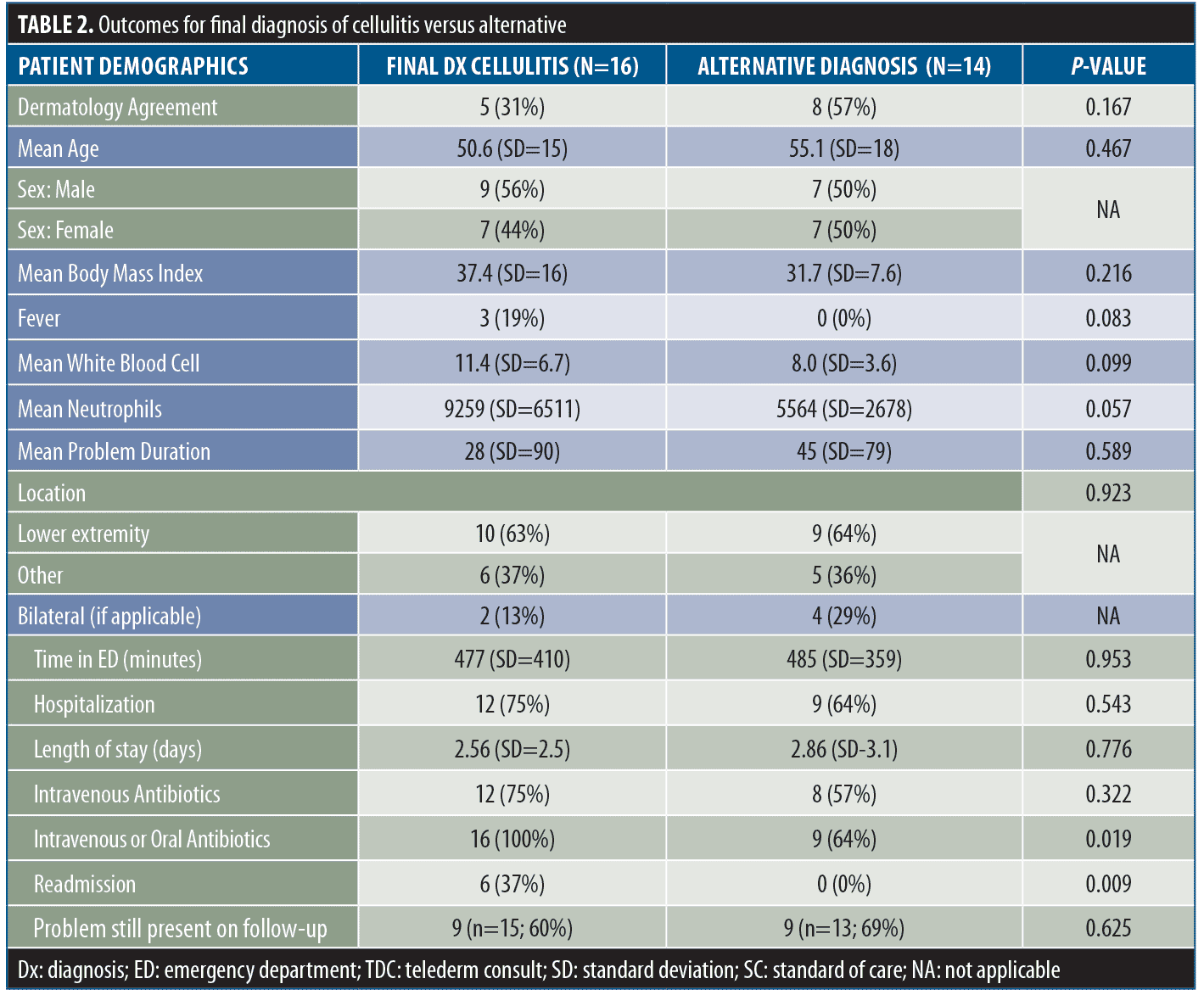 J Clin Aesthet Dermatol. 2020;13(4):43–44
J Clin Aesthet Dermatol. 2020;13(4):43–44
by Alexandra Wells, MD; Preeta Gupta, MD, Francis Tian, MD; Eric Adkins, MD; and Benjamin Kaffenberger, MD
Drs. Wells, Tian, and Gupta are with The Ohio State University College of Medicine in Columbus, Ohio. Dr. Adkins is with the Department of Emergency Medicine at The Ohio State University Medical Center in Columbus, Ohio. Dr. Kaffenberger is with the Division of Dermatology at the Wexner Medical Center at Ohio State University in Columbus, Ohio.
FUNDING: No funding was provided for this study.
DISCLOSURES: The authors have no conflicts of interest relevant to the content of this article.
ABSTRACT: There is a shortage of dermatologists available to see hospitalized patients, especially for urgent evaluations such as in the emergency department setting. The use of teledermatology in the emergency setting was studied for patients presenting to the emergency department with symptoms of or a diagnosis of cellulitis. Thirty patients were enrolled and randomized to a teledermatology note being placed in their chart versus control patients undergoing standard care. Although randomized, in this small pilot study, the locations of involvement were unbalanced across treatment groups. The mean length of stay was slightly longer in the group randomized to teledermatology; however, this was largely related to the unbalanced number of patients presenting with bilateral and lower extremity complaints in the teledermatology group. This study provides important preliminary data for future studies, including ensuring appropriate balancing of locations of involvement, a larger sample size, and more rigid entry criteria.
KEYWORDS: Cellulitis, teledermatology, telemedicine, emergency department, clinical trial
Cellulitis is an acute infectious process of the dermis and subcutaneous adipose tissue, most commonly caused by Streptococcus or Staphylococcus species. Although a bacterial infection, surface cultures are typically negative, leaving physicians reliant on patient history and physical evaluations to make the diagnosis,1,2,3 thus increasing the chances of misdiagnosis. Pseudocellulitis (e.g., acute lymphedema, lipodermatosclerosis, stasis dermatitis, stasis panniculitis) can often be mistaken for cellulitis, leading to high healthcare resource utilization.4 Here, we pilot a randomized, controlled trial including patients with cellulitis or pseudocellulitis at a single medical center emergency department (ED) to evaluate the feasibility of teledermatology in this setting.
Eligible patients presented to the Ohio State University Emergency Department and were identified with a “likely cellulitis” diagnosis by the triage nurse based on a warm, erythematous skin condition often on an extremity. After patient consent was obtained, the patients were randomized to either a teledermatology consult (TDC) arm or standard of care (SC) by a study coordinator. A brief history was taken, including duration, exacerbating and remitting factors, medications usage and changes, history of cellulitis, and problem area with digital images taken of the affected area. Images and data of patients who were randomized to the TDC arm were emailed to the dermatology attending, who responded with recommendations, which were placed in each patient’s chart by the coordinator.
Thirty patients met initial criteria. The TDC and SC groups were generally well-matched, with the exception of higher absolute neutrophil count, inflammatory markers, and more frequently affected sites other than the lower extremity (LE) in the TDC group. (Table 1). In both groups, similar numbers were admitted with a diagnosis of cellulitis and six in each group were discharged with that diagnosis (Table 1). The dermatology consultations generally agreed with patients who had a discharge diagnosis of cellulitis. While the rates of diagnosis agreement were similar between the TDC and SC groups, more TDC patients received intravenous antibiotics (85% vs. 53%), and had a longer length of stay (LOS) (4 vs. 1.7 days). The SC patients had lower rates of persisting cellulitis-like symptoms at the 30-day follow-up (58% vs. 69%) (Table 1).

Patients were also divided by final disposition diagnosis: cellulitis or pseudocellulitis. Analysis performed on these groups revealed a more balanced distribution between location and LOS, but the patients with cellulitis had a higher rate of readmission (37%), compared to zero percent of the patients with pseudocellulitis (Table 2).

Ultimately, our pilot data showed a high rate of persistent disease in both arms, low rate of diagnosis adoption, and higher rates of true cellulitis than outpatient studies.5 Several limitations affected our feasibility study, notably that ED physicians did not request nor necessarily expect a consultation in the chart, social barriers to discharge in this setting, and a higher rate of true cellulitis probably related to allowance of puncture wounds and ulcers, compared to previous outpatient studies.5 A high rate of persistent disease at 30 days was identified in both groups, highlighting the necessity for further innovation and research in this area.
Recommendations for future studies include precise powering of the study to reflect social barriers and higher rates of “true” cellulitis, gold standard development, limiting ED offerings to a single unit to ensure emergency physicians are familiar with the study (rather than >100 emergency physicians), or “on-demand” care that is specifically requested by the emergency physician.
References
- Vary JC, O’Connor KM. Common dermatologic conditions. Med Clin North Am. 2014;98(3):445–485.
- Phoenix G, Das S, Joshi M. Diagnosis and management of cellulitis. BMJ. 2012;345:e4955.
- Hirschmann JV, Raugi GJ. Lower limb cellulitis and its mimics: part 1. Lower limb cellulitis. J Am Acad Dermatol. 2012;67(2):163.e1–e12.
- Lozano R, Naghavi M, Foreman K, et al. Global and regional mortality from 235 causes of death for 20 age groups in 1990 and 2010: a systematic analysis for the Global Burden of Disease Study 2010. Lancet 2012;380(9859):2095–2128.
- Arakaki RY, Strazzula L, Woo E, Kroshinsky D. The impact of dermatology consultation on diagnostic accuracy and antibiotic usage among patients presenting with suspected cellulitis to outpatient internal medicine offices: a randomized-controlled trial. JAMA Dermatol. 2014;150(10):1056–1061.

